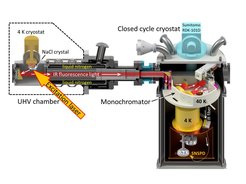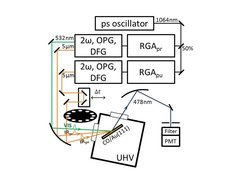Time-resolved spectroscopy of surface absorbates
Time-resolved infrared laser-induced fluorescence (IRLIF)
The performance of infrared emission spectroscopy as a tool for molecular sciences has considerably improved in recent years with the emergence of new mid-IR detectors providing single photon sensitivity and high temporal resolution. Based on an amorphous tungsten silicide (WSi) superconducting nanowire single-photon detector (SNSPD) we implemented a IRLIF experiment to examine vibrational energy pooling of carbon monoxide (CO) deposited on a NaCl(100) crystal surface at cryogenic temperatures1. For the first time, the vibrational state-resolved dynamics is observed down to the CO monolayer level2.

Figure 1: Experimental setup to measure vibrational energy pooling of CO deposited on a NaCl(100) surface. The sample is placed in a UHV chamber, cooled to about 7 K, and vibrationally excited with a ns laser pulse. The emitted fluorescence photons are dispersed in a monochromator operating at 40 K and directed to the SNSPD using a mid-IR multimode fiber. Light collection optics and radiation shields are cooled below 90 K to suppress background photons from black-body radiation.

Figure 2: Experimental setup to measure the vibrational lifetime of CO on Au(111) by pump-probe sum frequency generation.
Figure 2: Experimental setup to measure the vibrational lifetime of CO on Au(111) by pump-probe sum frequency generation.
Pump-probe sum frequency generation (SFG)
A central assumption of the Langmuir-Hinshelwood (LH) reaction mechanism of heterogeneous catalysis is that reactants on a surface thermalize with the solid much faster than reaction can occur. For vibrationally excited molecules the validity of the thermalization assumption depends on the rate of vibrational relaxation. For molecules chemisorbed to metal surfaces vibrational lifetimes are typically 1-3 ps. But there are experimental hints that vibrational lifetimes of physisorbed species on metals are considerably longer, e.g. for the system CO on Au (111).3 We use pump-probe vibrational SFG to measure vibrational lifetimes of adsorbates interacting weakly with metal surfaces to explore the possibility of driving chemistry with vibrationally activated species. With an intense infrared pump pulse (IRpu) molecules are vibrationally excited. The population relaxation towards thermal equilibrium is monitored with a time-delayed tunable infrared/532 nm (IRpr/VIS) probe pulse pair generating the sum of the two incident frequencies.
Literature
1. L. Chen, D. Schwarzer, V. B. Verma, M. J. Stevens, F. Marsili, R. P. Mirin, S. W. Nam and A. M. Wodtke, Acc. Chem. Res. 50, 1400-1409 (2017).
2. L. Chen, J. A. Lau, D. Schwarzer, J. Meyer, V. B. Verma and A. M. Wodtke, Science 363, 158-161 (2018).
3. P. R. Shirhatti, I. Rahinov, K. Golibrzuch, J. Werdecker, J. Geweke, J. Altschäffel, S. Kumar, D. J. Auerbach, C. Bartels and A. M. Wodtke, Nature Chem. 10, 592-598 (2018).

